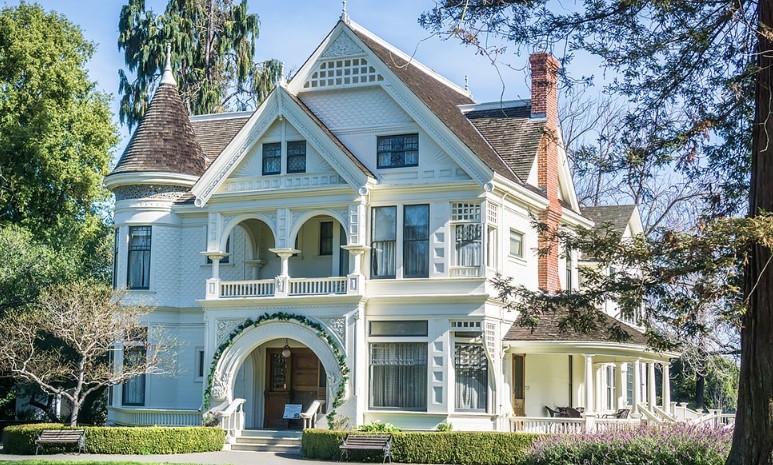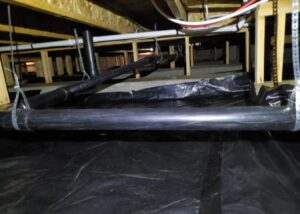Rise of the Insta-renovators: revamping their homes for an online audience

Smashing through a wall, reinstating original fanlights, removing 1960s gas fireplaces to discover pretty Victorian tiles underneath . . . Such delights are familiar territory to those people who see a vision of their perfect family home through the peeling textured wallpaper of an unloved semi-detached.
Some homeowners have always been inclined to renovate, attempting to keep the dust behind the scenes until the place is vaguely inhabitable. Increasingly, though, people are sharing their home renovation dramas on social media, captivating thousands of strangers and even making enough money to bankroll their interior design projects.
TikTok and YouTube have become star-makers of a handful of people turning their homes into content farms, with accounts such as @eastcoastDIY, who is building her second home in as many years and attracts 5.8mn TikTok followers. But it is Instagram that has seen the broadest change over the past few years. After exchanging contracts and picking up the keys, people are now setting up dedicated Instagram accounts for their homes.
Chelsea Stonier, who is 33 and from Shropshire, is documenting her second Victorian home renovation on @thehousethatblackbuilt, which she set up in 2017. She was among the first clutch of British home renovators to do so.
“There were probably only two or three [well-known] home-renovator accounts at the time,” she says over Zoom from a taupe-walled room. “Some of the bigger accounts used to throw parties for the Instagram community, it was that small. You knew everybody, you followed everybody and there wasn’t anybody that you didn’t follow who wasn’t part of that community. That was around 2018; it’s not like that anymore.”

Whatever your inclination (inspiration, practical DIY intel, pure snooping), whatever era of property you’re interested in, chances are there will be a renovator steadfastly documenting their wallpaper peeling, damp-proofing, extension-building activity on Instagram.
Some of note: @townley_terrace, a Georgian seafront home in Kent, run by textiles artist Jessie Cutts with a keen dedication to archival research; Emily Jane Lathan, whose eponymous account now accommodates a loving renovation of a 1970s bungalow in Teesside, of which she is only the second owner; @goodboneslondon, an ambitious and glossy renovation of a Victorian terrace in north London by American emigrants Leanne Kilroy and Eric Fulwiler; @07.crescent_locationhouse, a double-fronted beauty on the English south coast presided over by stylist Charlie Davis, her partner and their two small children; @whathavewedunoon, a rough-and-ready rescue of a derelict villa in Scotland and @thevitamindproject, Africa Daley-Clarke’s socially conscious journey of a family home. Nearly all of them have amassed followers in the tens, if not hundreds, of thousands.
The fascination with the inside of others’ — often more beautiful — homes is not new. The first interior design magazines appeared in the 1890s. A century on, editorial focus had shifted from the living spaces of the rich and famous to those belonging to ordinary, if tasteful, people.
Digital cameras, internet access and the introduction of interiors blogging and Pinterest in 2012 paved the way for early influencers to share home decor inspiration and “hacks” — innovative DIY solutions. Today, interiors are valuable content, with renovators and amateur designers engaging with their growing online audiences, from offering advice to sharing polls to vote on whether they paint their walls one shade of off-white or another.
“It’s such a booming, profitable and growing market,” says Nadine Bacchus-Garrick, 32, who left her full-time job in PR and influencer marketing just over a year ago to concentrate on her refreshingly honest renovation account @rona_renovation. “DIY content is top-performing on Pinterest, top-performing on YouTube, it’s just huge.”

At first, neither Stonier nor Bacchus-Garrick expected to monetise their renovations. Stonier maintains a full-time job, as she doesn’t want to feel obliged to post on demand. Bacchus-Garrick says that while she can live on earnings from her account, it’s still “the wild west” in terms of how much influencers can charge for content.
“What I can say with confidence is that big brands are increasingly expected to put a good chunk of budget and output towards working with influencers,” she adds, over email.
Bacchus-Garrick and her partner got the keys to their terraced house in Croydon, south London, in the first week of lockdown: “I vividly remember queueing to get into the supermarket and the solicitor ringing to say, ‘It’s done.’” On furlough with no commute, “we just decided to gut the house immediately ourselves”.
Bacchus-Garrick set up the account a few days after getting the keys, thinking renovations were too “boring” for her personal Instagram. Three years on, @rona_renovation has 29,000 followers and has collaborated with brands such as B&Q, Aldi and Neff.
Collaborations vary with every influencer, brand and budget, but it’s not uncommon for accounts with tens of thousands of followers to command four-figure sums for posting on Instagram, as well as — or instead of — gaining “product” in the form of white goods, paint or furniture. “It kind of grew arms and legs,” she says.

Stonier’s primary impulse behind creating @thehousethatblackbuilt was “to keep me motivated. I was embarrassed [of the renovation account]. I kind of didn’t want anybody that knew me to know about it because it wasn’t about anything other than just keeping track of what we’re doing.” Named after her experimentation with the colour black at home (“we found that with it we had really found our style”), the account now has a following of 134,000.
She didn’t work on her first brand collaboration until late 2019 (“somebody sent me a £30 vase and it was just really exciting, it was so novel to me”). Now working on a larger Victorian home after an uptick in followers and greater awareness among brands of the power of influencer marketing, Stonier says she and her husband have been able to afford better tradespeople and fittings due to her social media income and product collaborations: “the vast majority of this house renovation is paid for by Instagram.”
Both Stonier and Bacchus-Garrick have done an admirable amount of work in their homes themselves, alongside hiring professional tradespeople. But neither are interior designers by training, making them among the majority spearheading the renovation accounts movement. Interior design markets itself with professional photographs, often in magazines, but the before-and-after “reveal” is the money shot among the influencer community.
But Patrick Williams, half of the Bath-based interior design practice-cum-shopkeeper Berdoulat, is among the professionals who have shared their knowledge and aesthetics on Instagram. Williams grew up renovating an 18th-century French farmhouse — his family home — that became his company’s namesake.
“My first pocket money was earned cleaning tiles,” he laughs, adding that he encourages his own children to get involved. He says that in his interiors approach, “The building is the client: let the building call the shots in terms of what’s done to it, and that tends to result in spaces that feel right.”


Williams always saw Instagram as a shopfront of its own, specifically for Berdoulat: “It was a very useful commercial tool for singing from the rooftops about what we do as a practice.” But he understands the inherent generosity of renovation accounts. “There’s a fine line between going, ‘Here’s a post about a chimney breast and I’ve hidden an extractor fan in it and aren’t I clever’ and actually being quite helpful and informative and saying, ‘You can source this here’ and giving people the resources to do it themselves,” he says.
He follows specialised accounts: @richardsonstudiointeriors, run by Celia McCarthy, who is transforming a 1960s bungalow, and @reubarchi, or architectural designer Reuben Higgins, who now works for Ben Pentreath, interior designer to Catherine, Princess of Wales.
This democratisation has led to a certain homogenisation of how our homes look — at least on Instagram. “Trends and fads can be catalysed very quickly,” says Williams. “Before, you’d wait for six issues of a magazine to come out before a scallop detail became a thing. Now it can happen in a couple of weeks.”
Particular trends, such as having a microcement bathroom or lining your walls in MDF to create fake panelling, feel entirely gestated on Instagram. “I swear I started the panelling trend,” says Stonier, half in jest. “I panelled my front room in February 2018 and that’s definitely taken on crazy momentum because it’s something that people can DIY.”

It’s a homogeneity that developed in an absence of inclusivity; while many interiors accounts grew in lockdown, as people looked to their phones for ways to improve their stay-at-home surroundings, it was noticeable to Bacchus-Garrick what kind of homes were rising to the top of the algorithm.
“At the time, the home interior and DIY space was exclusively white and very middle class,” she says. “It was so whitewashed that there were black accounts that were doing well, but they weren’t showing [their faces] out of fear of it having a negative impact on their growth.”
In 2020, she was invited to an online collective by @blackfamilyvictorianrenovation’s Michelle Healey, one of Instagram’s few visible black renovators.
“What struck us is that we were completely excluded from this narrative,” says Bacchus-Garrick. “I took it personally: my grandma got here from Jamaica during the Windrush era and she’s been a homeowner since the 1970s. We have a tradition of tradespeople in our community. The fact that we were part of it in real life — we own and renovate homes — and not online was annoying.”
Together, Healey’s collective created @blackhomesuk, which shares interiors from the black British community.


A few years on, the Instagram interiors landscape is more diverse. “There are black renovators who have got a luxury budget, and others taking five-bedroom houses back to brick. It’s not just that we’re seeing more black people, but also different types of black people renovating in different ways,” says Bacchus-Garrick.
Nobody I spoke to expects the fascination with renovation — and the desire to document it online — to go away. Some creators are responding to the cost of living crisis in real time, offering up bargain versions of designer finds and easy DIY tricks to spruce up homes without bringing in the builders.
But beyond the economy, there’s a greater shift towards sustainability: in a climate crisis, repairing feels more virtuous than replacing. For Williams, it’s been a long time coming. “When I set up the practice 18 years ago, I had a manifesto,” he says. “It compared the organic food movement to how we could approach our homes: that flat-pack furniture that won’t survive a house move would never be passed on to the next generation, but a chest of drawers with dovetail joints will. People are a lot more aligned with that way of thinking now.”

Pale pink sofas and industrial bathrooms may come and go, but if people are learning more about their homes and how to enjoy them through social media, it could lead to a more conscientious way of living. People have always lived among beautiful mishmashes of different styles — Instagram’s influence is just making them easier to create.
“Classic design borrows from all sorts of places,” Williams says. “It’s like a folk song, it’s reinterpreted all the time, but it doesn’t belong to any particular era. And therefore, it won’t go out of date.”
Find out about our latest stories first — follow @FTProperty on Twitter or @ft_houseandhome on Instagram








